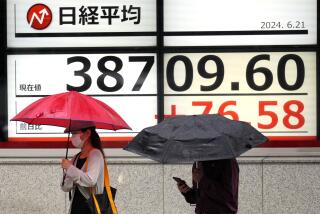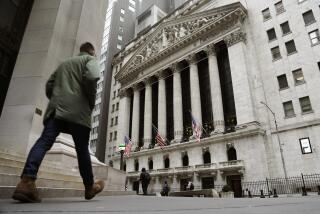Investors Continue to Enter Enron Fray
With Enron Corp.’s stock practically selling for a song, who would want to buy it? Lots of people.
Even though the stock stands a good chance of becoming worthless if Enron files for bankruptcy reorganization, trading of the shares again reached eye-popping levels Thursday. About 270 million shares changed hands after 339million--a single-day record for an individual stock--crossed the tape Wednesday on the New York Stock Exchange.
Enron shares plunged 25 cents further, or 41%, to close at 36 cents on the NYSE. Last December, the stock reached nearly $85 a share.
Part of the volume involved big mutual funds and other money managers selling Enron shares that were in their Standard & Poor’s 500 index funds, which are passively managed funds that mimic the index and its stocks.
Enron, which had been a component of the S&P; 500, was removed at the end of trading Thursday and replaced by Nvidia Corp., a Santa Clara, Calif.-based maker of computer-graphics chips. As the funds sold Enron and bought Nvidia to keep their index funds current, Nvidia jumped $2.25 to $53.61 on Nasdaq.
But other institutional investors simply sold Enron to cut their losses, with Wall Street speculators as the buyers, analysts said.
Much of the trading action, they said, involved steely nerved pros trading the stock back and forth in a bid to squeeze a few pennies of profit while Enron’s epic debacle plays itself out.
“Our sense is that it’s professional traders, trading on speculation” that they can resell the stock a minute or an hour later for a fraction more than they paid, said Douglas Christopher, an energy analyst at Crowell, Weedon & Co. in Los Angeles.
He and others said so-called vulture funds and various hedge funds--which specialize in risky bets on low-priced stocks of faltering companies--also were big players in Thursday’s trading.
Some individual investors probably were making the same bet, but the massive volume clearly showed that money managers and other institutional investors accounted for most of the trading.
And there was money to be made for savvy or lucky traders. Consider: Enron’s stock traded as low as 30 cents a share Thursday before finishing at 36 cents. Anyone who bought the stock at 30 cents and sold at 36 cents turned a 20% profit in a day.
Many widely known mutual funds and money-management firms ranked among Enron’s 10 largest stockholders as of Sept. 30, according to filings with the Securities and Exchange Commission, though it is not known how many still own the stock or, if they do, how many shares.
They included the Janus, Putnam, Fidelity and Vanguard fund families, along with Alliance Capital and the California Public Employees’ Retirement System, or CalPERS, which had held 3 million Enron shares.
CalPERS, with $150 billion in assets, held most of its Enron stock in index funds and thus couldn’t sell until the stock was removed from the index, said CalPERS spokeswoman Pat Macht.
Some of CalPERS’ actively managed funds also held Enron, “but all but one of our active managers has sold” the shares, she said. CalPERS has a loss of $42 million on paper for its Enron holdings, she said, adding that the Enron loss “doesn’t create a material threat” to the overall fund.
*
Bloomberg News was used in compiling this report.
More to Read
Inside the business of entertainment
The Wide Shot brings you news, analysis and insights on everything from streaming wars to production — and what it all means for the future.
You may occasionally receive promotional content from the Los Angeles Times.











